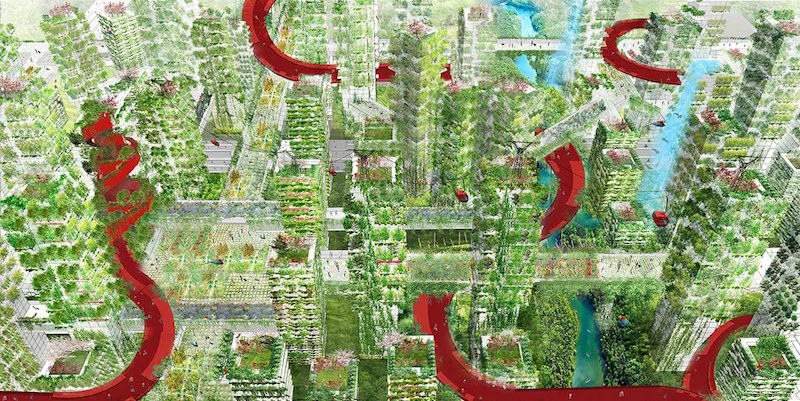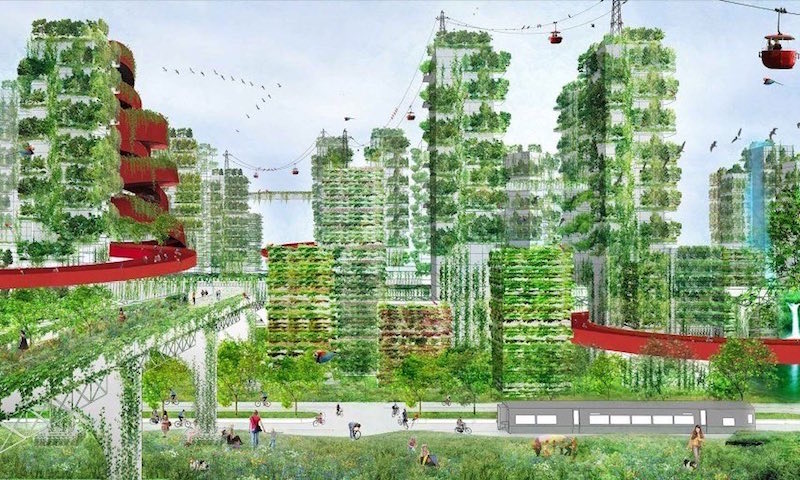Not long ago, Stefano Boeri Architetti announced their plans to create the first ‘vertical forest’ in China. The building would be covered in over 3,000 plants and absorb 25 tons of CO2 per year and produce 60 kilograms of oxygen per day. The goal of the project was to help rectify one of China’s biggest problems: air pollution.
The Nanjing Vertical Forest is a start in creating cleaner air for the country, but its small scale means it can only do so much. An entire city of vertical forests, however, may be able to provide the boost in air quality the country needs. Stefano Boeri Architetti’s new vision for China is to create ‘forest cities’ where every building is a vertical forest, covered in greenery and cleaning the air.
The cities would have the appearance of a post-apocalyptic city in the process of being reclaimed by nature. Only, where the streets of a post-apocalyptic wasteland would be empty and the infrastructure a crumbling mess, these forest cities would be bustling hives of activity, just like any other city.
The first of these sustainable mini-cities would be located in Luizhou, a Chinese city of about 1.5 million people, the Guardian reports. Another of these forest cities is being conceived around Shijiazhuang, a city that is consistently among China’s ten most polluted.
Forest City Shijiazhuang would consist of five districts (petals) each hosting 20,000 residents. Each petal would be a mixed-use environment with residential housing, offices, retail spaces, public spaces, and gardens. The growth of Forest City Shijiazhuang would focus on the vertical space, and reduce urban sprawl.
It is estimated that every square meter of a Vertical Forest façade will absorb 0.4 kilograms of CO2 per year, which means the plants housed in the vertical facades of the buildings will absorb about 1,750 kilograms of CO2 per year collectively, and that isn’t even including the plants located in the parks and gardens.
The vegetation on the outside of the buildings will absorb CO2, but will also help with cooling costs. In the summertime the vegetation will reduce the heating of the facades by up to 30 degrees and create a natural difference in the inside and outside temperature of about three degrees, further adding to the sustainability of the city.
While much of the recent data has pointed toward making cities denser in order to make them more sustainable, Boeri thinks these mini-cities of 100,000 people or fewer and constructed of green architecture are a more sustainable solution than huge, densely populated cities of 10 to 20 million people.
Boeri told the Guardian the firm is already working on designing the different buildings for the forest city proposal. The first forest city could even begin construction by the end of this year and be completed by 2020.
 Image courtesy of Stefano Boeri Architetti.
Image courtesy of Stefano Boeri Architetti.
Related Stories
| Sep 13, 2010
Triple-LEED for Engineering Firm's HQ
With more than 250 LEED projects in the works, Enermodal Engineering is Canada's most prolific green building consulting firm. In 2007, with the firm outgrowing its home office in Kitchener, Ont., the decision was made go all out with a new green building. The goal: triple Platinum for New Construction, Commercial Interiors, and Existing Buildings: O&M.
| Sep 13, 2010
'A Model for the Entire Industry'
How a university and its Building Team forged a relationship with 'the toughest building authority in the country' to bring a replacement hospital in early and under budget.
| Sep 13, 2010
Data Centers Keeping Energy, Security in Check
Power consumption for data centers doubled from 2000 and 2006, and it is anticipated to double again by 2011, making these mission-critical facilities the nation's largest commercial user of electric power. With major technology companies investing heavily in new data centers, it's no wonder Building Teams see these mission-critical facilities as a golden opportunity, and why they are working hard to keep energy costs at data centers in check.
| Aug 11, 2010
CHPS debuts high-performance building products database
The Collaborative for High Performance Schools (CHPS) made a new tool available to product manufacturers to help customers identify building products that contribute to sustainable, healthy, built environments. The tool is an online, searchable database where manufacturers can list products that have met certain environmental or health standards ranging from recycled content to materials that contribute to improved indoor air quality.
| Aug 11, 2010
29 Great Solutions for the AEC Industry
AEC firms are hotbeds of invention and innovation to meet client needs in today's highly competitive environment. The editors of Building Design+Construction are pleased to present 29 "Great Solutions" to some of the most complex problems and issues facing Building Teams today. Our solutions cover eight key areas: Design, BIM + IT, Collaboration, Healthcare, Products, Technology, Business Management, and Green Building.
| Aug 11, 2010
Walmart establishes sustainable product index to evaluate 'greeness' of products
Walmart today announced plans to develop a worldwide sustainable product index during a meeting with 1,500 of its suppliers, associates and sustainability leaders at its home office. The index will establish a single source of data for evaluating the sustainability of products.
| Aug 11, 2010
9 rooftop photovoltaic installation tips
The popularity of rooftop photovoltaic (PV) panels has exploded during the past decade as Building Teams look to maximize building energy efficiency, implement renewable energy measures, and achieve green building certification for their projects. However, installing rooftop PV systems—rack-mounted, roof-bearing, or fully integrated systems—requires careful consideration to avoid damaging the roof system.
| Aug 11, 2010
USGBC’s Greenbuild 2009 brings global ideas to local main streets
Save the planet with indigenous knowledge. Make permanent water part of your life. Dive deep water for clues to environmental success. Connect site selection to successful creative concepting. Explore the unknown with Discovery Channel’s best known guide. These are but a few of the big ideas participants can connect to at USGBC’s Greenbuild International Conference and Expo, taking place on November 11-13, 2009 in Phoenix, Ariz.










